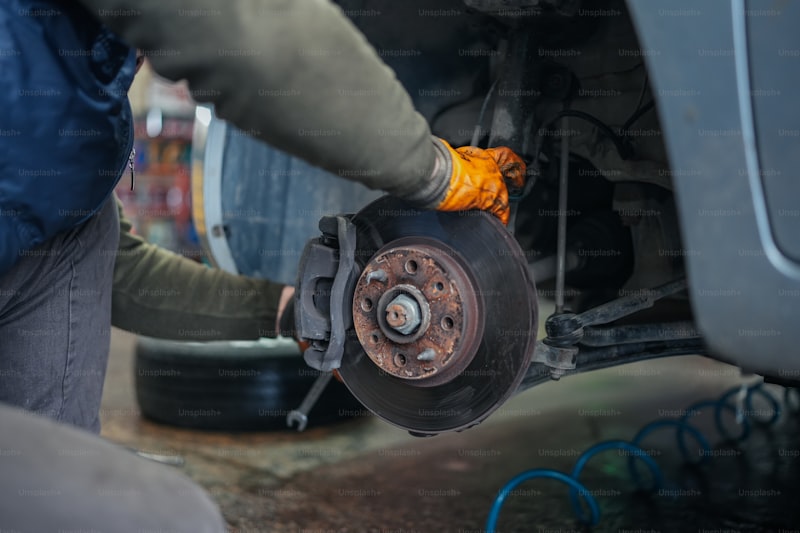Has your car been showing signs of brake issues lately? One common culprit could be worn-out brake lines. These vital components carry brake fluid from the master cylinder to the brake calipers, ensuring your vehicle stops safely and efficiently. Over time, brake lines can corrode, develop leaks, or become worn due to exposure to road debris and weather conditions. Addressing this issue promptly is crucial for your safety on the road.
Identifying worn-out brake lines early can save you from potential brake failure. Keep an eye out for signs such as brake fluid leaks under the car, a soft brake pedal that goes all the way to the floor, or a dashboard warning light indicating low brake fluid. If you notice any of these symptoms, it’s advisable to inspect your brake lines immediately.

Fixing worn-out brake lines is a task that requires attention to detail but can be done with the right tools and knowledge. Here’s a basic guide to help you through the process:
-
Prepare Your Tools: Gather brake line wrenches, flare nut wrenches, tubing cutter, brake fluid, and a tubing bender before starting.
-
Locate the Problem: Jack up your car and locate the worn-out brake line. Follow the line from the master cylinder to the brake calipers or wheel cylinders.
-
Remove the Old Line: Carefully disconnect the old brake line using the appropriate wrenches. Be cautious to avoid damaging surrounding components.
-
Install the New Line: Cut a new brake line to match the length of the old one. Use a tubing bender to shape it as needed. Connect it securely using new fittings and tighten them properly.
-
Bleed the Brakes: Once the new line is installed, bleed the brake system to remove any air bubbles. This ensures proper brake function and pedal feel.
By following these steps, you can effectively replace worn-out brake lines and restore your car’s braking performance. Remember, if you’re unsure or uncomfortable performing this repair yourself, it’s always best to consult a professional mechanic.
Mastering Brake Line Replacement: A Step-by-Step Guide
Firstly, why would you need to replace brake lines? Over time, brake lines can deteriorate due to exposure to elements like moisture and road salt, leading to potential leaks or even brake failure. Regular inspection is crucial, and if you notice any signs of corrosion or damage, it’s time to consider replacement.
Before starting, ensure you have all the necessary tools and materials ready. You’ll typically need a flare nut wrench, line wrench, tubing cutter, flare tool, brake fluid, and replacement brake lines of the correct length and type for your vehicle.
Safety first! Park on a flat surface and secure the vehicle with wheel chocks. Open the hood and locate the brake fluid reservoir. Remember to wear safety glasses and gloves throughout the process.
Start by locating the old brake lines running from the master cylinder to the brake assemblies. Using a flare nut wrench and line wrench, carefully loosen and remove the fittings at both ends of the brake line.

Take precise measurements of the old brake lines or use them as templates to cut the new brake lines to the correct length. A tubing cutter ensures clean and straight cuts, crucial for proper sealing.
With the new lines cut to size, install them by first securing the fittings loosely. Use a flare tool to create double flares on the ends of the brake lines, ensuring a secure connection. Tighten the fittings carefully to avoid stripping or damaging the threads.
Once all new brake lines are securely in place, bleed the brake system to remove any air bubbles and ensure proper brake pedal feel and responsiveness. Refer to your vehicle’s manual for the correct bleeding sequence and use fresh brake fluid.
After bleeding the brakes, test the brake pedal for firmness. Check around all fittings and connections for leaks. Top up the brake fluid reservoir to the recommended level.
Mastering brake line replacement requires attention to detail and adherence to safety precautions. By following these steps diligently, you can ensure your vehicle’s braking system operates smoothly and safely, giving you peace of mind on the road.
DIY Brake Line Repair: Tools and Techniques You Need to Know
If you’ve ever wondered about tackling DIY brake line repair, you’re not alone. Understanding the basics of this crucial automotive task can save you time and money while ensuring your vehicle runs smoothly and safely. Let’s dive into the tools and techniques you need to know to get the job done right.
First things first, safety comes before anything else. Before starting, gather your tools: a tubing cutter, flare nut wrenches, tubing bender, double-flare tool, brake fluid, and of course, replacement brake lines. These tools are your best friends when it comes to executing a repair that’ll stand the test of time.
Now, onto the techniques. Begin by identifying the damaged brake line and safely raising the vehicle using jack stands. Once elevated, use your flare nut wrench to carefully loosen the fittings on each end of the damaged line. With the old line removed, it’s time to measure and cut the new tubing to match the length of the original line precisely.
Next up, bending the tubing to fit the contours of your vehicle’s undercarriage. A tubing bender is invaluable here, allowing you to shape the line without kinks that could restrict fluid flow. Once bent, use the double-flare tool to create secure ends on the tubing. This step ensures a tight seal when reconnecting to the brake system, preventing leaks that could compromise braking performance.
After securing the new line in place, bleed the brakes to remove any air bubbles and top up with fresh brake fluid. It’s a meticulous process, but essential for maintaining brake responsiveness.
By mastering these tools and techniques, DIY brake line repair becomes a manageable task. Remember, practice makes perfect, and each successful repair boosts your confidence under the hood. Ready to roll up your sleeves and give it a shot?
Saving Money on Car Maintenance: DIY Brake Line Fixes
Before diving in, it’s crucial to gather the necessary tools and materials: replacement brake lines, tubing cutter, flare tool, tubing bender, brake fluid, and a flare nut wrench. Safety goggles and gloves are also a must for protecting yourself during the repair process.
Begin by identifying the damaged brake line. Look for signs of corrosion, leaks, or soft spots. Once located, use the tubing cutter to carefully remove the affected section of the brake line. Measure and cut the replacement line to match, ensuring it fits snugly into place.
Next, use the tubing bender to shape the new brake line as needed. This ensures proper alignment and prevents kinks that could affect brake performance. Once shaped, use the flare tool to create flares at both ends of the brake line. These flares are crucial for securing the line to the brake fittings securely.
After flaring, carefully thread the new brake line into position, using the flare nut wrench to tighten connections. Double-check all fittings to ensure they’re secure and leak-free. Once everything is in place, refill the brake fluid reservoir and bleed the brake system to remove any air bubbles.
Expert Tips for Identifying and Repairing Brake Line Damage
Firstly, visual inspection is key. Regularly check your brake lines for signs of damage such as rust, corrosion, or leaks. These can indicate weakened spots that need immediate attention. Look closely along the entire length of the brake lines, especially where they connect to the brake calipers and master cylinder.
Secondly, perform a brake fluid check. Brake fluid plays a critical role in hydraulic brake systems. Low brake fluid levels or fluid leaks can point to underlying brake line problems. Monitor the fluid reservoir regularly and look for any signs of moisture or discoloration, which can signal a leak in the brake lines.
Thirdly, test your brakes regularly. If you notice spongy or soft braking, it could indicate air or fluid leakage within the brake lines. Conduct a brake pedal test by pressing firmly on the brake pedal while the engine is running. A soft or sinking pedal suggests potential brake line issues that require immediate inspection.
Moreover, address any unusual noises. Grinding or squealing sounds when applying the brakes may indicate brake line damage or wear on the brake pads. These noises should prompt a thorough inspection of the brake system, including the brake lines, to identify the source of the problem.
Lastly, consult a professional mechanic for thorough inspections and repairs. Brake line issues can be complex and require specialized knowledge and tools for proper diagnosis and repair. A qualified mechanic can conduct pressure tests, replace damaged lines, and ensure the entire braking system operates safely and efficiently.
By staying proactive and attentive to these expert tips, you can effectively identify and address brake line damage, ensuring your vehicle’s braking system remains reliable and safe on the road.
Frequently Asked Questions
How Can I Identify Brake Line Leaks
Learn how to identify brake line leaks with our concise guide. Discover common signs like fluid puddles under your car, soft brake pedal, or illuminated brake warning light. Inspect visible brake lines for rust, cracks, or wet spots, and check brake fluid levels regularly. Promptly address any signs of leaks to ensure safe braking performance.
What are the Signs of Worn-out Brake Lines
Discover the signs of worn-out brake lines to ensure your vehicle’s safety and performance. Learn how to identify common symptoms such as brake fluid leaks, spongy brake pedal feel, and decreased braking responsiveness.
What Tools Do I Need to Replace Brake Lines
Discover the essential tools required to replace brake lines efficiently. Learn about the specific tools like flare wrenches, tubing benders, and line wrenches that are crucial for the job. Ensure safety and precision with the right equipment for your brake line replacement project.
Should I Replace Brake Lines Myself or Seek Professional Help
Learn whether it’s best to replace brake lines yourself or seek professional assistance with this concise FAQ. Get clear guidance on choosing between DIY and professional service for brake line replacement.
Step-by-Step Guide: How to Replace Brake Lines
Learn how to replace brake lines with our step-by-step guide. This concise tutorial provides clear instructions to safely replace worn or damaged brake lines on your vehicle, ensuring proper functionality and safety.


